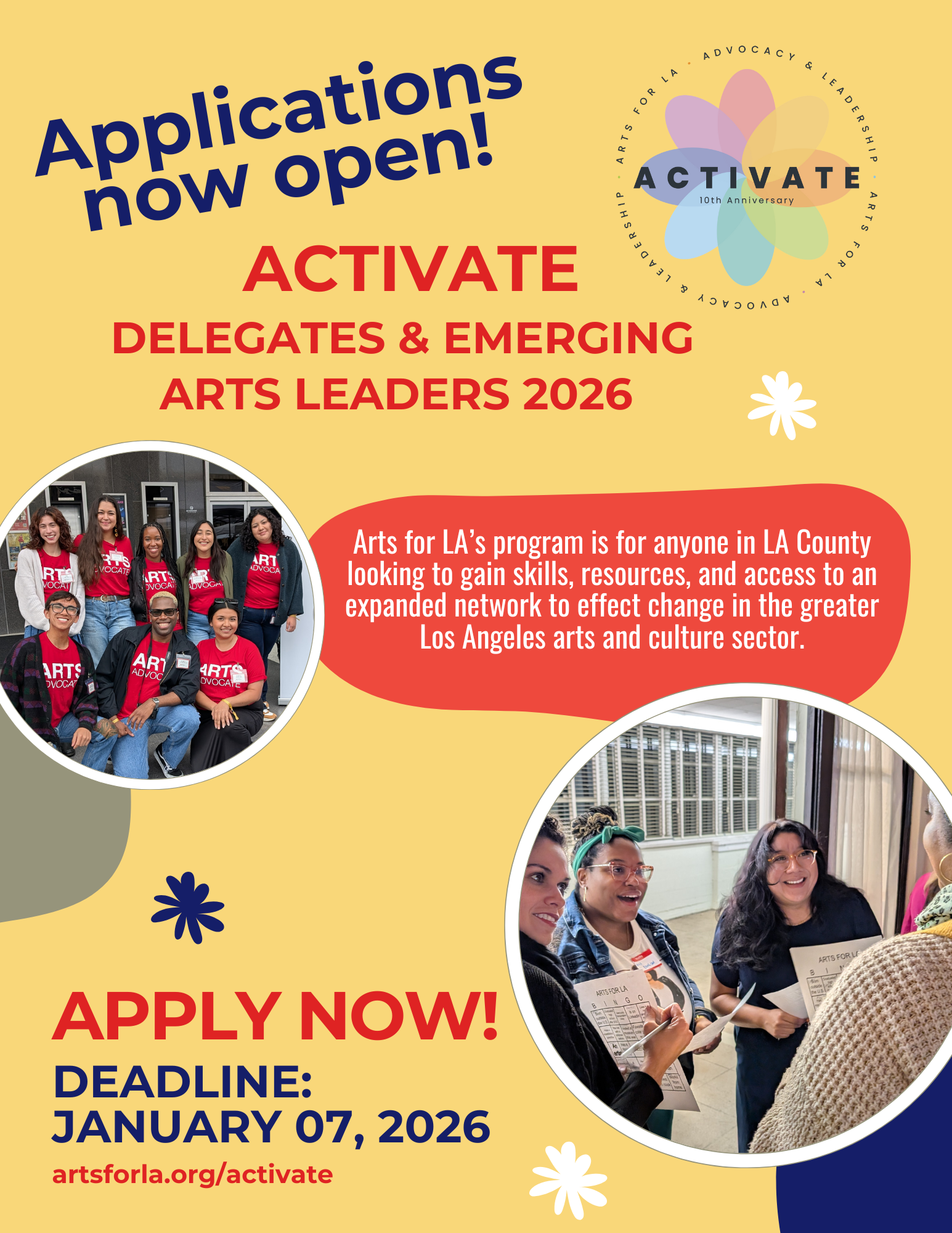From Ricky’s Desk: June
Jun 20, 2024“The Great Paradox: How Slashing the Arts Contradicts Economic Growth”
By Ricky Abilez
This month, arts advocates spent weeks making calls and sending letters to legislators asking them to prevent significant cuts at the state and local levels. Mayor Karen Bass and Governor Gavin Newsom approved their respective budgets and our hard work paid off – for now. We collectively clawed back $1 million for 11 restored positions at the city level and $17.5 million at the state level. But those returned funds do not even meet the status quo. What do we do when this happens again? Difficult budget years depend on public servants making informed and, oftentimes, difficult decisions. However, there’s a dangerous, harmful, and often overlooked pattern that occurs when those decisions are made – putting the arts and culture on a chopping block at a disproportionate rate.
This trend, alarmingly evident in California, underscores a broader, deeply entrenched misunderstanding of the indispensable role the arts and culture play in our society. Our state is often hailed as a cultural mecca but currently ranks 38th in the nation for per capita arts spending, trailing behind states like Florida. However, Governor Ron DeSantis recently vetoed $32 million in arts funding from the legislature-approved 2024-25 budget, effectively wiping out the entire state arts budget.
Even more startling is the position Los Angeles is in: we rank number one in arts providers per capita but fall behind at number 87 in total government support. We often tout ourselves as the creative capital of the world but fail to bolster that reputation with public and private investment. For example, Los Angeles County’s per capita arts investment in its local agency ($1.77 per resident) is astonishingly low when compared to San Diego ($11.05 per resident) and San Francisco ($33.22 per resident).
This paradoxical situation perpetuates a harmful “starving artist” narrative which insinuates we create art for arts sake because our work is entertaining to consume, but does not provide sustainable livelihoods or tangible benefits. This is abjectly false and disregards the multifaceted impacts the arts and culture have on our economic health and well being.
In 2021 alone, the creative economy was home to 7.6% of California jobs. Each job supported by creative industries resulted in nearly $38,000 of additional tax revenue, generating over $194 billion in federal, state, and municipal taxes. These creative industries are foundational to both the bottom line and global competitiveness of Los Angeles and California.
With such an outsized impact, it’s no wonder the Governor proposed the California Arts Council be moved under the Office of Economic Development (Go-Biz). But what the proposal did not account for is the fact that creative sectors contribute to the economy despite low investment. Approximately 41% of arts organizations are vulnerable to financial crises, stagnant wages, employment insecurity, or even closure. The Governor’s failure to recognize the paradox of moving our only statewide arts agency under an economic development umbrella while slashing arts funding by 58%, would have worsened the crisis of undercapitalization. Thankfully, the state legislature opposed the Governor’s suggested move, recognizing that the solution is not to relocate the agency, but to invest in its services.
Though economic data is compelling, we cannot rely upon numbers alone. The arts and culture also yield positive results for regional health and vibrancy. They bridge social divides, build community cohesion, stimulate local businesses, enhance property values, increase academic achievement, reduce crime and recidivism, inspire civic participation, and foster empathy.
Time and time again, the arts have proven to be powerful tools for social change and community development. They offer platforms for diverse voices and perspectives, truly putting equity principles and values into action. We must advocate for a shift in perception. It is more important than ever for public officials and funders to understand the immense social and economic value of the arts and culture – not as embellishments but necessities. It is clear that the public disconnect is not malicious, but rather, a result of distorted storytelling.
Creative storytellers must lead a collective and concerted effort to educate and engage consumers, legislators, and funders alike. They must highlight success stories that demonstrate vast economic impacts, such as Beyonce’s Renaissance Tour (which generated $4.5 billion for the U.S. economy), and projects with broad community benefits, such as Destination Crenshaw (soon to be a 1.3-mile stretch of pocket parks, hundreds of newly planted trees, and over 100 commissioned works of art along Crenshaw Boulevard). Narrative change is never easy, but it begins with you. Join us in this mission to elevate the arts and unlock their full potential to drive social, economic, and cultural progress.
 ✨ Learn more about the programs and apply 👉
✨ Learn more about the programs and apply 👉